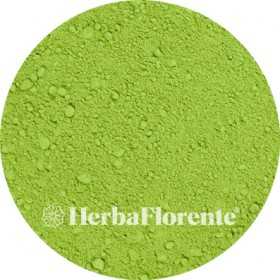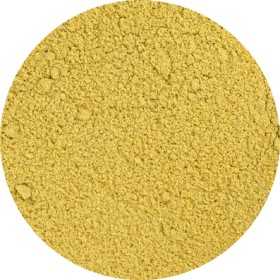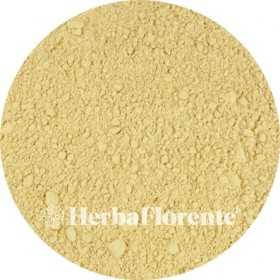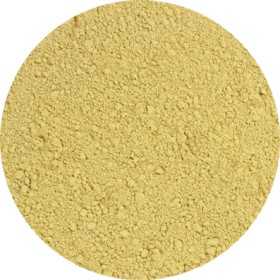F, G, H, I, J
There are 7 products.
Barley grass - Hordeum vulgare
Barley grass (Hordeum vulgare) is obtained by allowing barley to fully germinate and then cutting off the green shoots when they reach a height of 20 to 30 cm. This grass is known for its high nutrient density. It is packed with bioflavonoids, beta-carotene and a wide range of vitamins, including A, B1, B2, B3, B6, B12, C, E and K. In addition, barley grass contains minerals such as calcium, phosphorus, potassium, iron and zinc. Barley grass powder is also a rich source of chlorophyll and contains all essential amino acids.
€2.60
From: €2.60
Fennel - Foeniculum vulgare - Grounded
Fennel (Foeniculum vulgare) is a plant belonging to the lacecap family (Apiaceae). It has a distinctive flavor reminiscent of anise, and both the threadlike branches of the leaves and the seeds are used as a herb and spice.
Originally from Asia and the Mediterranean, fennel was brought to Europe via medieval trade routes. Fennel is widely grown, especially in Southern Europe, and is an important ingredient in salads and other dishes.
Chewing fennel seeds can suppress the feeling of hunger. In the past, believers who went to church sober sometimes chewed fennel seeds during the church service.
Originally from Asia and the Mediterranean, fennel was brought to Europe via medieval trade routes. Fennel is widely grown, especially in Southern Europe, and is an important ingredient in salads and other dishes.
Chewing fennel seeds can suppress the feeling of hunger. In the past, believers who went to church sober sometimes chewed fennel seeds during the church service.
€2.60
From: €2.60
Fenugreek - Foenugraeci graecum
Fenugreek (Trigonella foenum-graecum), also known as fenugreek, boxhorn trefoil or Greek hay, is known for its various health benefits. It can help stimulate appetite, support the immune system and promote fat metabolism.
This versatile plant is mainly used as a spice in Indian cuisine. The aromatic leaves of fenugreek are also used to mask the bitter taste of medicines. Originally from the Mediterranean region, fenugreek later gained popularity in Asia.
Fenugreek is rich in essential minerals such as iron and copper. In addition, it contains saponins and coumarins, where coumarins are known for their pleasant hay-like scent.
This versatile plant is mainly used as a spice in Indian cuisine. The aromatic leaves of fenugreek are also used to mask the bitter taste of medicines. Originally from the Mediterranean region, fenugreek later gained popularity in Asia.
Fenugreek is rich in essential minerals such as iron and copper. In addition, it contains saponins and coumarins, where coumarins are known for their pleasant hay-like scent.
€2.00
From: €2.00
Ginkgo (Maidenhair tree) - Ginkgo bilobae
Maidenhair tree (Ginkgo biloba), also known as the Japanese Temple Tree, has been used in traditional Chinese herbal medicine for centuries. Ginkgo biloba is used to improve blood circulation, promote concentration and support memory. The main components of ginkgo biloba are (bio)flavonoids (flavonglycosides), bilobalides and ginkgolides (terpene lactones).
It is a unique deciduous tree that is considered a species with no direct family ties. Charles Darwin called the ginkgo biloba a 'living fossil' because it has been around for about two hundred and fifty million years. Ginkgo originally comes from China.
It is a unique deciduous tree that is considered a species with no direct family ties. Charles Darwin called the ginkgo biloba a 'living fossil' because it has been around for about two hundred and fifty million years. Ginkgo originally comes from China.
€3.20
From: €3.20
Ginseng (Panax) - Panax ginseng
Panax Ginseng is a plant with a slow-growing, sturdy root. Panax Ginseng is considered one of the most important medicinal herbs in traditional Chinese medicine. In fact, it is even the world's most famous herb. Panax ginseng has been used for more than 5,000 years to optimize human health and well-being in Asia. In the world of Chinese ethnopharmacology, it has been used for more than 3,000 years.
Panax takes its name from the Greek word “panacea”, which means “all-healer”. Gingsen is currently the world's most popular and most powerful adaptogenic herb. Adaptogenic herbs help the body to deal with stress in a natural way and achieve a homeostatic balance between body and mind.
Panax takes its name from the Greek word “panacea”, which means “all-healer”. Gingsen is currently the world's most popular and most powerful adaptogenic herb. Adaptogenic herbs help the body to deal with stress in a natural way and achieve a homeostatic balance between body and mind.
€16.00
From: €16.00
Juniper Berries - Juniper communis
The juniper berry (Juniperus communis) is rich in vitamin C and antioxidants, which occur naturally in its berries. These antioxidants protect our body cells against harmful influences such as pollution and sunlight. In addition, they support digestion and contribute to healthy kidney function and fluid balance.
The juniper is a conifer native to Europe, Asia and America. This tree bears flowers and berries at the same time, which can be green and black. The name Juniperus is derived from the Celtic word 'juneprus', meaning rough, prickly or bitter, and 'communis' meaning plain. Since ancient times, the berries have been used by Greeks and Romans for their health benefits.
The juniper is a conifer native to Europe, Asia and America. This tree bears flowers and berries at the same time, which can be green and black. The name Juniperus is derived from the Celtic word 'juneprus', meaning rough, prickly or bitter, and 'communis' meaning plain. Since ancient times, the berries have been used by Greeks and Romans for their health benefits.
€2.60
From: €2.60
Licorice - Glycyrrhiza glabra, Liquiritiae
Licorice (Glycyrrhiza glabra) is a versatile herb that plays an important role in Ayurvedic medicine. It is known for its beneficial effects on digestion and maintaining flexible joints, while also soothing the respiratory tract.
This plant is grown in various parts of the world, including Europe, Asia and the Middle East. It is a hardy plant that even thrives in the Netherlands. However, it takes three to four years before the roots can be harvested.
In addition to the roots, the leaves can also be used, for example to make tea. Licorice is widely used in foods and pharmaceuticals because of its sweet taste and other ingredients.
This plant is grown in various parts of the world, including Europe, Asia and the Middle East. It is a hardy plant that even thrives in the Netherlands. However, it takes three to four years before the roots can be harvested.
In addition to the roots, the leaves can also be used, for example to make tea. Licorice is widely used in foods and pharmaceuticals because of its sweet taste and other ingredients.
€2.00
From: €2.00





















